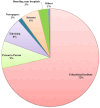Assessment of Knowledge and Attitudes Related to HIV/AIDS Among the Population With Increasing Incidence Rate
- PMID: 38435229
- PMCID: PMC10909385
- DOI: 10.7759/cureus.53451
Assessment of Knowledge and Attitudes Related to HIV/AIDS Among the Population With Increasing Incidence Rate
Abstract
Introduction Lack of awareness and negative attitudes toward people living with HIV/AIDS (PLWHA) are key barriers to minimizing the transmission of HIV. Therefore, the present survey-based study aimed to assess the knowledge regarding HIV/AIDS and attitudes toward PLWHA. Methods In the present study, we collected data from 612 Kyrgyz national participants using a self-administered questionnaire. Results Among the participants, 59% (361) were females, and 41% (251) were males. The mean age of the participants was 26.23 (SD = 7.7) years. All participants were aware of HIV/AIDS, and 59.1% (362) agreed to have sufficient information about HIV/AIDS. Overall, the participants displayed a high level of knowledge about HIV/AIDS transmission, and 89.2% (546) of them were aware of sexual transmission of HIV/AIDS. Among the participants, 54% (330) believed that using condoms during sexual intercourse could prevent the transmission of HIV/AIDS. Concerning social attitudes, 17% (104) of the participants agreed that HIV-infected individuals should be isolated from society. Moreover, 39% (238) of them disagreed to work with PLWHA. The results of the study suggest that female participants were more aware of the modes of HIV/AIDS transmission than males. However, misconceptions regarding transmission routes were present in both genders. Conclusion The present study revealed that study participants had correct knowledge about HIV/AIDS transmission modes such as unsafe blood transfusion and injectable drug abuse. However, knowledge about unsafe tattooing and mother-to-baby mode of HIV/AIDS transmission was observed to be lower. Female participants were found to be more aware of HIV/AIDS transmission. There is a need to address the knowledge and awareness gap in the general population of Kyrgyzstan, especially among the male population.
Keywords: assessment; attitude; hiv/aids; knowledge; kyrgyzstan.
Copyright © 2024, Khan et al.
Conflict of interest statement
The authors have declared that no competing interests exist.
Figures


References
-
- World Health Organization. HIV and AIDS. [ Dec; 2023 ]. 2023. https://www.who.int/news-room/fact-sheets/detail/hiv-aids/ https://www.who.int/news-room/fact-sheets/detail/hiv-aids/
-
- Knowledge about HIV/AIDS and its transmission and misconception among women in Bangladesh. Bhowmik J, Biswas RK. https://doi.org/10.34172/ijhpm.2022.6321. Int J Health Policy Manag. 2022;11:2542–2551. - PMC - PubMed
-
- Zhao F, Benedikt C, Wilson D. Human Development Perspectives. Washington, DC: World Bank; 2020. Tackling the world’s fastest-growing HIV epidemic: more efficient HIV responses in Eastern Europe and Central Asia.
LinkOut - more resources
Full Text Sources
Miscellaneous
